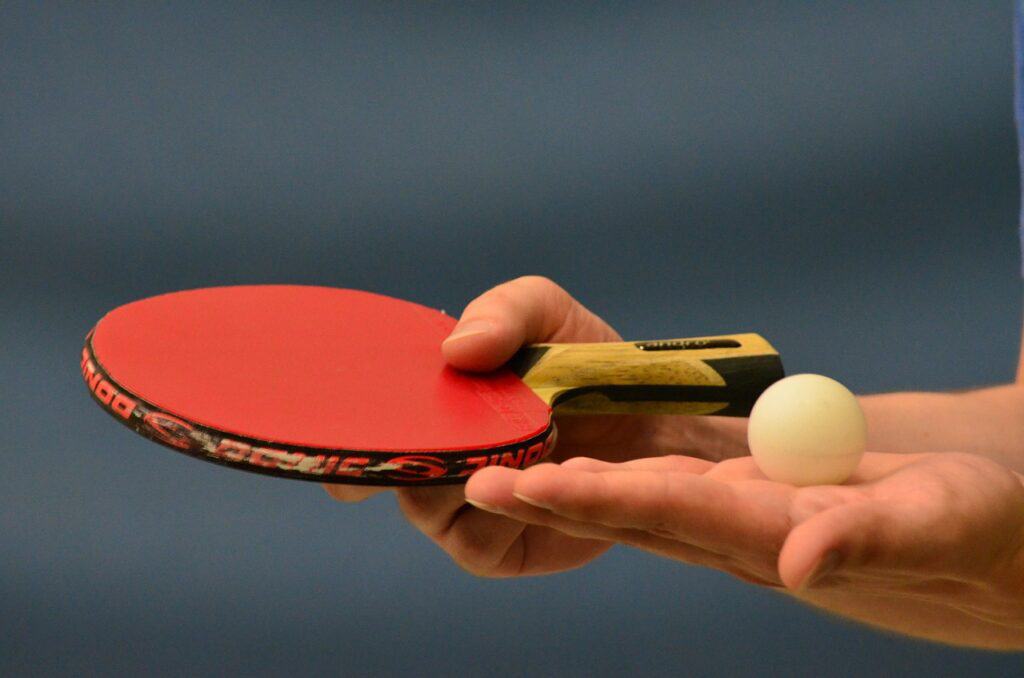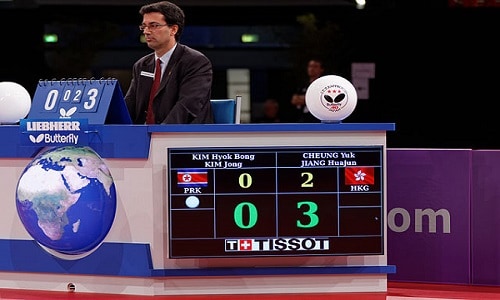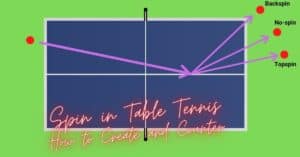Like in every sport, the knowledge of rules and regulations in table tennis has the utmost importance not only for the experienced but also for beginners. When you start playing table tennis, you must note the basic rules but there are many untold complicated rules that you may discover in the later stages. If you don’t follow those rules properly at the early stages, you will be habituated to the wrong practices that are not healthy for the development of your skills.
What is Table Tennis?
Table tennis is a sport that involves two or four players. It is played on a surface of dimensions 2.74 m (9.0 ft) x 1.525 m (5.0 ft) x 76 cm (2.5 ft).
The game is played with the help of a racket that hits a ping pong ball to cross over the net to bounce on the opponent’s side. It looks simple! Yes, but it must follow the rules and regulations governed by the International Table Tennis Federation (ITTF) which we know as “Official table tennis rules”.
Let’s look at the basic rules that are essential to follow in the game of table tennis.
Table Tennis Rules Singles
A singles match involves two players with a predefined set of rules which are as follows:
1. Serve Rules
You must know the service rules of Table Tennis. This will restrict you from doing illegal services.

The following rules will guide you in delivering a legal table tennis serve.
- Stand behind the end of the table. You can stand in any position to serve.
- You should take the ball in the open palm of your non-playing hand and throw it vertically without imparting any kind of spin, so it rises to a minimum height of 16 cm or 6.3 inches.
- During the period of service, the ball must be above and behind the playing surface.
- At the time of falling, hit the ball, so it hits your side once and then bounces over the net. After bouncing over the net, the ball must also drop on the table of the opponent’s side to make it a valid service.
- You can’t hit the ball over the table. You must hit the ball behind the table.
- If the ball hits the net and doesn’t go over, the point goes to your opponent player.
- When the server throws the ball for service, the ball is “in play”.
- You can’t hide the ball from your opponent during service.
2. No. of Table Tennis Serve
- ITTF changed the rule in 2001. Till 2000, a player had a consecutive 5 service. Then it was the turn of the opponent player until the game ended at 21 points. If it reached a stage of 20-20 (i.e. the Deuce), the service altered until a player gained 2 points lead to win the game.
- Now a player serves for 2 consecutive times until either of the players reaches 11 points to finish the game. At 10-10, the service alternates for each player, till a player gains a lead of 2 points.
3. Let in Table Tennis
“Let” is the situation when a rally is interrupted and you have to serve again. In many circumstances, an umpire may call “let”.
- The ball must pass cleanly over the net. If the ball touches the net and still bounces on the other side, then it is “let in table tennis” and you have to serve again. There is no rule on the number of consecutive ‘let’ services.
- If you deliver the service, but your opponent is not ready to react.
- If the umpire or the assistant interrupts during a match.
- If you fail to deliver a service or a return due to some outside occurrence that is beyond your control, then the umpire may call it “let”.
4. Don’t Touch the Table With Your Free Hand
At the time of returning a serve, you can stand in any position behind the table but it does not allow you to touch the table with your free hand or move the table.
5. Don’t Volley the Ball Like in Tennis
In tennis, you can volley a ball, but table tennis does not allow you to do so. You have to allow the first bounce. Then you hit the ball so it goes over the net and bounces on your opponent’s side.
6. If the Ball Strikes the Net But Bounces on the Other Side, it is a Correct Return
After returning the serve, if the ping pong ball strikes the net but bounces on your opponent’s table then it is considered a correct return. The ball may also touch the edge of the table, but not the vertical portion of the table.
7. If You Strike the Ball and it Bounces Back to Your Side, it’s Your Point
If you impart backspin during service or rally, the ball may come back over the net to your court after bouncing on the other side. In this situation, your opponent has to reach out to hit the ball and if he fails, the point goes to you.
8. If the Ball Touches Your Racket-handle, it Counts a Valid Return
While returning the ball in a rally, if the ball touches the handle of your racket, then it is a valid return. The racket handle includes your fingers and the portion before your wrist.
Table Tennis Rules Doubles

Every table tennis doubles rule is the same as a singles game except for the following exceptions.
- If you serve for your Doubles team, the ball must drop its first bounce on the right half portion of the table. After bouncing over the net, the ball must drop on the right half portion of the receiver.
- While playing a Doubles match, after switching over the service, the previous receiver becomes the new server and the partner of the previous server becomes the receiver.
- A doubles pair must strike the ball alternately.
- During a rally, play must continue in its sequence until a player of any team misses or hits the ball.
Table Tennis Rules Scoring

Before 2001, the winner of a table tennis match was decided based on “Ping Pong rules 21 points”. The player who reached 21 points, won the match.
In 2001, to increase the level of excitement in the game, ITTF changed the point system and till now it is continuing.
Now it is a game of 11 points. The player who first touches 11 points wins the game.
Exception: There may be a situation of 10-10, which is a Deuce in table tennis. In this stage of equality, a two-point lead is a must for winning the game.
Usually, a match consists of the best of any 3, 5, or 7 nos. of game.
How to Score in a Match
You score a point if your opponent mis-hits the ball, i.e. the ball does not bounce on your table. The same is true for your opponent.
These are the situations when a point will not be given in your favor.
- You fail to deliver a legal service.
- You miss the service.
- If the ball goes over the table in your service.
- After one bounce, you fail to hit the ball i.e. allow more than one bounce.
- You fail to keep the ball on the table of your opponent.
- You hit the ball twice in succession.
- In a doubles match, you hit the ball out of your turn.
- You obstruct the ball with your body or cloth.
- If you move the table, touch the net or table with your free hand during a match.
How to Indicate Score in Table Tennis
When a player wins a point, the umpire uses the following system to indicate the score of the game.
- The umpire calls the score as soon as the ball is out of play in a rally.
- When the umpire calls the score, he or she first calls the number of points of the player who is due to serve in the coming rally and then calls the point of the other player.
- After the game, the umpire calls the points of the winner followed by the loser.
- In addition to calling, the umpire may use the hand signal to indicate his or her decision.
- The umpire raises his arm nearer to the winning player. His upper arm is horizontal and the forearm is vertical with a closed hand.
- Whenever a rally is ‘let’, the umpire raises his or her hand to indicate that the rally has ended.
- A mechanical or electronic indicator is used to show the score to the players and spectators.
What is the Expedite System in Table Tennis?
In the Expedite system, a game is interrupted by the umpire even if the ball is in play and the game resumes with a new set of rules.
- The Expedite system will come into operation if the game goes longer than 10 minutes and the score is less than 18 points.
- If the ball is in play, the game will resume with the service of the player who was the server at the time of interruption by the umpire.
- If the ball is not in play, the game will resume with the service of the player who was the receiver in the preceding rally.
- After the Expedite system comes into operation, each server will serve once instead of two.
- After the return of the receiver, the assistant will shout counting the no. of returns. Suppose, the receiver makes 5 good returns, then after the 5th return, the assistant umpire will shout “five”.
- If the receiver gives 13 correct returns, he will get the point.
- Once introduced, the Expedite system will continue till the end of the match. Suppose a match is going on with the best of 5 games. If the Expedite system is introduced in the second game, the rest three games will also follow the Expedite system.
Today’s table tennis is mainly dominated by attackers. So in this fast-paced game, the Expedite system is very rare.
FAQs
In table tennis, a set consists of 11 points. But if it arrives at a situation of 10-10 points, then a 2-point lead is a must to win the set.
A table tennis match consists of the best of odd numbers of games, it may be 3, 5, or 7.
If the game arrives at a situation where both players have 10 points each, it is Deuce.
There is no limit to the number of let services till it follows the rules in table tennis.
Before 2001, table tennis followed the rule of 21 points. At present this rule is only applicable for ping pong, the recreational version of table tennis, where the game ends at 21 points if it does not arrive at 20-20.
Ping pong follows the scoring system of 21 points in a game if not arrived at a stage of equality of 20-20. In table tennis, a game ends at 11 points if not tied at 10-10. In both cases, a 2-point lead is a must to win the game. In ping pong, the server gets the chance for 5 consecutive services whereas, in table tennis, it is 2 services in a row.
In a singles game of table tennis, you can stand anywhere during service and place the ball anywhere on the opponent’s court. But in the doubles game, your service must go diagonally from the right half of your court to the right half of your opponent’s court.
As per the rule, the ball is allowed to touch the edge of the table but not the vertical side of the table.
Quick Recap
Let’s have a quick recap on the essential points of the rules and regulations.
- The rule starts with the ball in the open palm of your non-playing hand.
- You have to throw it vertically without imparting any spin for a minimum height of 16 cm or 6.3 inches.
- A player serves for 2 consecutive times until either of the players reaches 11 points to finish the game.
- At 10-10, the service alternates for each player, till a player gains a lead of 2 points.
- Hit the ball when it is falling so it hits your side once and then bounces over the net to hit the opponent’s side.
- The rule says that during a return or rally, you must hit the ball after the first bounce.
- A game is of 11 points and a match is a best of 3, 5, or 7 games.
For any type of latest update, you have to check the handbook released by ITTF every year.
Suggested Topic: “Ping Pong Vs Table Tennis: Are They Different Games?“



